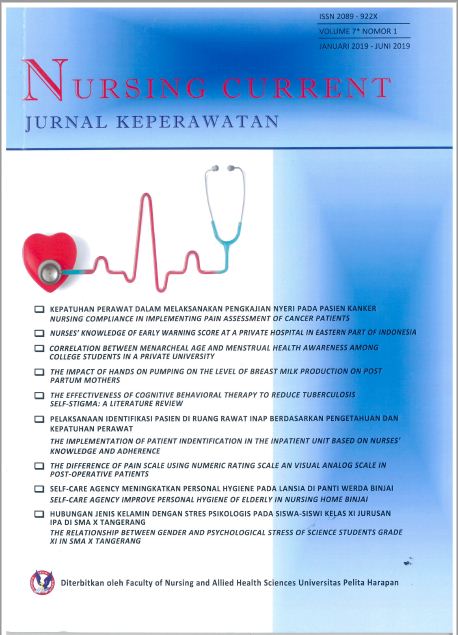THE IMPACT OF HANDS ON PUMPING ON THE LEVEL OF BREAST MILK PRODUCTION ON POST PARTUM MOTHERS
DOI:
https://doi.org/10.19166/nc.v7i1.2200Keywords:
Post partum mothers, hands on pumping, breast milkAbstract
The exclusive breastfeeding in Indonesia has not yet reached the national level target. Data from Private Hospital in West Jakarta found that there were only 60% of mothers who gave exclusive breast feeding in 2016, 38% of whom said they were unsuccessful due to low breast milk. The method that can be used to increase milk production is Hands on Pumping (HOP) technique, HOP is a technique of flushing the breast milk by relying on the strength of our thumb and index finger. To observe the effect of HOP on breast milk production in post partum mothers. We employed a quasi experimental design with pre and post test design, with the control group. The sample size was 68 mothers post multiparous partum with criteria 34 as the HOP experimental group and 34 post partum mothers as the control group (without HOP). On the third day of the intervention group there was a significant increase in breast milk production from the first day. The experimental group received HOP intervention (34 mothers) with a rise of 121.08 ml. This means that there is a difference in milk production before and after treatment. On the third day, the results of the p value are 0,000, with p value <0.05, which brought to the conclusion that there was an influence of HOP on breast milk production. HOP can significantly increase milk production. Next researcher is recommended to conduct similar research by paying attention to other factors that also affect breast milk production, such as psychological, nutrition, maternal breast conditions, and hormones.References
Amarille, E. (2016). Laporan Bulanan Sasaran Mutu ASI Eksklusif Ruang Bashan. Jakarta: Siloam Hospital Kebon Jeruk.
Badan Pusat Statistik. (2014). Statistik Indonesia. Jakarta: Badan Pusat Statistik.
Dharma, K. K. (2011). Metodologi Penelitian Keperawatan. Panduan Melaksanakan Hasil Penelitian. Jakarta: Trans Info Media.
Jiang, B., Hua, J., Wang, Y., Fu, Y., Zhuang, Z., & Zhu, L. (2015). Evaluation of the impact of breast milk expression in early postpartum period on breastfeeding duration: A prospective cohort study. BMC Pregnancy and Childbirth, 15(1). https://doi.org/10.1186/s12884-015-0698-6
Medela. (2016). How to Manually Express Breastmilk-The Marmet Technique. http://www.medelabreastfeedingus.com/tips-and-solutions/130/how-to-manually-express-breastmilk---the-marmet-technique
Mardiyaningsih, E., Setyowati, & Sabri, L. (2011). Efektifitas Kombinasi Teknik Marmet dan Pijat Oksitosin terhadap Produksi ASI Ibu Post Seksio di Rumah Sakit Wilayah Jawa Tengah. Jurnal Keperawatan Soedirman, 6(1), 31-38.
Notoatmodjo, S. (2010). Metode Penelitian Kesehatan. Jakarta: PT Rineka Cipta.
Perinasia. (2012). Bahan Bacaan Manajemen Laktasi (6th ed.).. Jakarta: Perinasia.
Polit, D. F. & Beck, C. T. (2012) Nursing Research: Principles and Methods. Philadelphia, PA: Lippincott Williams & Wilkins.
Republik Indonesia (2012). Peraturan Pemerintah Republik Indonesia Nomor 33 Tahun 2012 Tentang Pemberian Air Susu Ibu Eksklusif, pasal dua. http://www.kinerja.or.id/pdf/5dffecb9-4ca6-4e08-83de-2d4bb555d08f.pdf
Roesli, U., & Yohmi. (2009). Manajemen laktasi. Jakarta: IDAI.
Roesli, U. (2008). Inisiasi Menyusui Dini Plus ASI Eksklusif. Jakarta: Pustaka Bunda
Smerdon, P., & Wallace, R. A. (2013). ASI adalah penyelamat hidup paling murah dan efektif di dunia, UNICEF. https://www.unicef.org/indonesia/id/media_21270.html
World Health Organization/UNICEF. (2003). Global Strategy for Infant and Young Child Feeding. Geneva, Switzerland: World Health Organization.
World Health Organization. (2005). World Health Report 2005: Make Every mother and Child Count. https://www.who.int/whr/2005/whr2005_en.pdf?ua=1
World Health Organization. (2017). World Breastfeeding Week. http://www.who.int/mediacentre/events/2016/world-breastfeeding-week/en/
Downloads
Published
How to Cite
Issue
Section
License
Authors who publish with this journal agree to the following terms:
1) Authors retain copyright and grant the journal right of first publication with the work simultaneously licensed under a Creative Commons Attribution License (CC-BY-SA 4.0) that allows others to share the work with an acknowledgement of the work's authorship and initial publication in this journal.
2) Authors are able to enter into separate, additional contractual arrangements for the non-exclusive distribution of the journal's published version of the work (e.g., post it to an institutional repository or publish it in a book), with an acknowledgement of its initial publication in this journal.
3) Authors are permitted and encouraged to post their work online (e.g., in institutional repositories or on their website). The final published PDF should be used and bibliographic details that credit the publication in this journal should be included.

This work is licensed under a Creative Commons Attribution-ShareAlike 4.0 International License.






